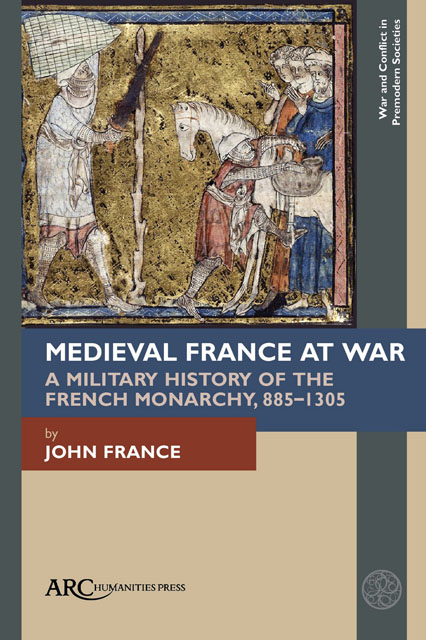Book contents
- Frontmatter
- Contents
- List of Illustrations
- Preface
- Introduction
- Chapter 1 Technology and Warfare
- Chapter 2 The Emergence Of France
- Chapter 3 French Monarchical Power in Context
- Chapter 4 Warfare In France To 1066
- Chapter 5 A Clash Of Dynasties 1066– 1180
- Chapter 6 Philip Ii and The Rise of France
- Chapter 7 The Expansion of France
- Chapter 8 Louis Ix and The Apogee Of French Power
- Chapter 9 The Problems Of Power
- Chapter 10 Perspectives on The Army of The Kings of France
- Bibliography
- Appendix: A Note on Sources
- Index
Chapter 2 - The Emergence Of France
Published online by Cambridge University Press: 06 April 2023
- Frontmatter
- Contents
- List of Illustrations
- Preface
- Introduction
- Chapter 1 Technology and Warfare
- Chapter 2 The Emergence Of France
- Chapter 3 French Monarchical Power in Context
- Chapter 4 Warfare In France To 1066
- Chapter 5 A Clash Of Dynasties 1066– 1180
- Chapter 6 Philip Ii and The Rise of France
- Chapter 7 The Expansion of France
- Chapter 8 Louis Ix and The Apogee Of French Power
- Chapter 9 The Problems Of Power
- Chapter 10 Perspectives on The Army of The Kings of France
- Bibliography
- Appendix: A Note on Sources
- Index
Summary
The “Frankish” Roots of Kingship
THERE WAS NO single moment when “France” was invented. The name slowly came to be applied to the area ruled by the Capetian monarchs, the descendants of Odo of Paris. Before the late thirteenth century, though, it was never a coherent territorial entity but, rather, a collection of lands, rights, and claims presided over by them. It is interesting, however, that the Anglo Saxon Chronicle refers to the people who conquered England in 1066 as “French”. Suger, abbot of St. Denis, wrote a life of Louis VI (1108– 1137) in which he usually describes what we now call the Île de France— broadly, the area of Capetian domination between Seine and Loire— as Francia. Since he was close to the monarchy and a great supporter of Louis VI, it seems that he regarded this area as truly France. On the other hand, he sometimes speaks of broader territories as being Francia, notably referring to the events of 1124, when Louis VI led a resistance from all over Gaul to repel a German invasion. This seems to speak of both an actuality— the confinement of the monarchy to the Île de France— and a pretention, to a much wider dominion. The idea of France was emerging but it was very diffuse. We can certainly see Flanders as part of the French world, even though its counts were subjects of the German empire for some of their lands, while the Normans were effectively assimilated to French culture, as were the Bretons. After 1066 England became a French colony. So, in the search for the French army, the net can be cast widely.
When can we speak of a French monarchy, a French kingdom, a French people, or France? Essentially, France emerged out of a quite different identity, and even by the end of our period it barely resembled a nation in our sense of the word, in which people of a common language and culture live within defined frontiers under a single sovereign power. Yet a monarchy, around which modern France crystallized, did exist as a separate entity after 843: the portion of the Frankish Empire acquired by Charles the Bald.
- Type
- Chapter
- Information
- Medieval France at WarA Military History of the French Monarchy, 885-1305, pp. 25 - 34Publisher: Amsterdam University PressPrint publication year: 2022



